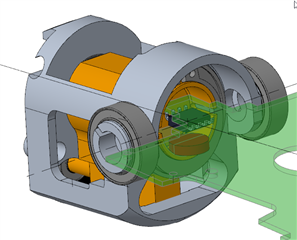Other Parts Discussed in Thread: TMAG5273, TMAG5253
We have an application that incorporates a joystick mechanism, and we currently use a Melexis 90333 Hall Effect sensor that is mounted with the Hall plate on the intersection of the pitch and roll axes, as shown below. A 6mm diameter, 1.5mm thick neodymium magnet (shown in red) is mounted 2.9mm from the hall plate.
Joystick movement causes the Hall-Effect chip to roate in pitch (Y) and roll (X) by +/- 7deg.



Although the arrangement works, there is some output from the Hall sensor on the pitch (Y) axis when the only input is roll (X), and vice-versa. Calibrating the Hall-Effect chip does not solve the problem. One possible cause of the problem is a small amount of play when the joystick is in the rest position.
I also realise that having the Hall sensor pivot rather than move in arc is not conventional, but I don't think this is the problem.
We have now started a re-design process and are looking at Texas Instruments Hall-Effect chips in the hope of better support. Part of the redesign should eliminate all of the play when the joystick is in the rest position. In addition, we are looking at the magnet a sensor arrangement.
It looks like we have two options:
- Re-design the mechanism to eliminate any unwanted movement or play in the rest position and change the sensor to something like the TMAG3001
- Isolate rotation about the X and Y axes by using a separate magnet and sensor on each axis.
What Texas Instruments part numbers would be good options here? It doesn't need to be particularly low powered, high accuracy is important, we need high-reliability, but there is redundancy elsewhere.
I have read the TI reference document SLYU064A, and few data sheets, but would be grateful for some more specific guidance.
Thanks in advance,
Sam

